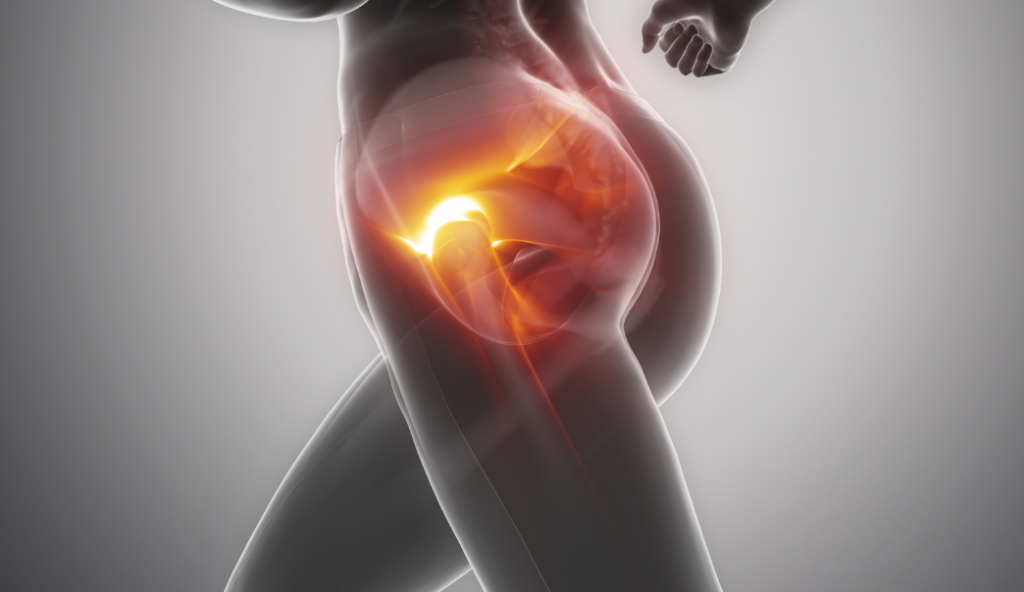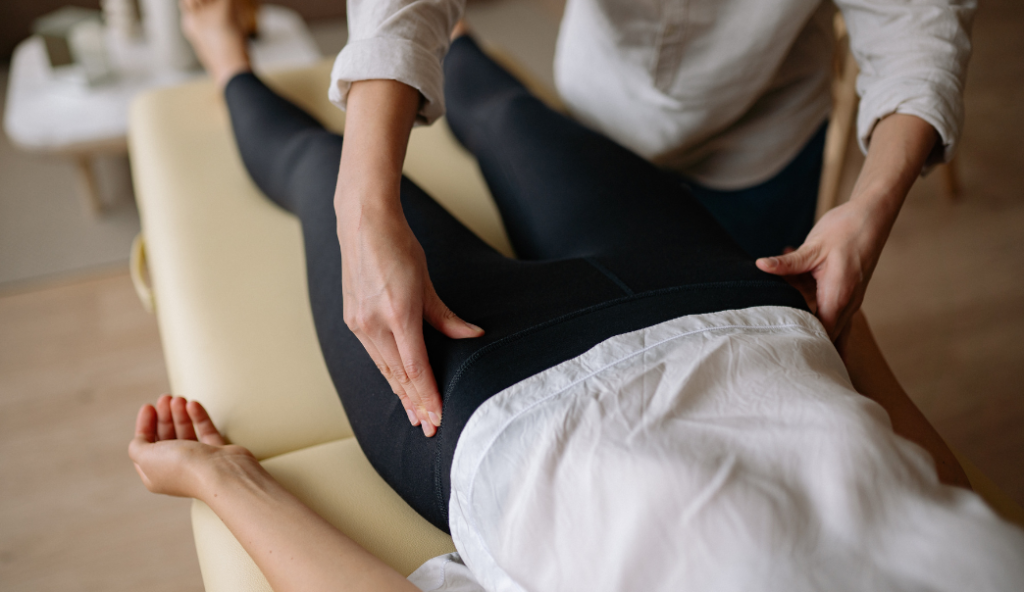Are you tired of constantly dealing with hip pain? Do you wish there was a natural and effective way to find relief? Look no further than the power of massage therapy. Not only can massage help to alleviate pain and discomfort, but it can also target the underlying causes, offering you long-term relief. In this article, we will explore the causes of hip pain and how massage therapy can be harnessed to bring you the relief you’ve been searching for.
Understanding the Causes of Hip Pain
If you’re experiencing hip pain, it’s essential to understand the root cause. Hip pain can be attributed to various factors, including arthritis, tendonitis, bursitis, muscle pain, and other underlying conditions. Let’s delve deeper into each of these causes to gain a better understanding.
Exploring the Role of Arthritis in Hip Pain
Arthritis is a common cause of hip pain, particularly in older adults. It occurs when the cartilage in the hip joint begins to wear down, leading to inflammation and discomfort. Arthritis can make even simple movements, like walking or climbing stairs, incredibly painful. However, you can effectively manage and alleviate this pain with the right approach.
Several types of arthritis can affect the hip joint. Osteoarthritis, the most common form, is caused by the gradual breakdown of cartilage over time. Rheumatoid arthritis, on the other hand, is an autoimmune disease that causes inflammation in the joints, including the hips. Other types of arthritis, such as psoriatic arthritis and ankylosing spondylitis, can also contribute to hip pain.
Managing arthritis-related hip pain involves a combination of medication, physical therapy, lifestyle modifications, and possibly surgery in severe cases. Working closely with your healthcare provider to develop a personalized treatment plan that addresses your specific needs and goals is important.
Unraveling the Connection Between Tendonitis and Hip Pain
Tendonitis refers to the inflammation of the tendons in the hip joint. This condition often occurs due to repetitive movements or injury. Tendonitis can result in a sharp or burning pain in the hips, making it challenging to carry out daily activities. Understanding the link between tendonitis and hip pain is crucial for finding the appropriate treatment.
Common causes of hip tendonitis include overuse, improper form during physical activities, and sudden increases in activity levels. Athletes, especially runners and dancers, are prone to developing hip tendonitis. Additionally, tight hip muscles and imbalances in muscle strength can contribute to the development of this condition.
Treatment for hip tendonitis typically involves a combination of rest, physical therapy, anti-inflammatory medications, and targeted exercises to strengthen the hip muscles. In severe cases, corticosteroid injections or surgery may be necessary to alleviate symptoms and promote healing.
Shedding Light on Bursitis as a Cause of Hip Pain
Bursitis is another common cause of hip pain. The inflammation of the bursae causes it; small fluid-filled sacs cushion the joints. When the bursae become inflamed, they can cause intense pain and restrict movement. Proper knowledge of bursitis can help you take the necessary steps towards finding relief.
Several bursae in the hip joint can become inflamed and lead to hip pain. For example, Trochanteric bursitis affects the bursa on the outside of the hip, causing pain that radiates down the thigh. On the other hand, Iliopsoas bursitis affects the bursa located on the inside of the hip and can cause pain in the groin area.
Treatment for hip bursitis typically involves a combination of rest, ice or heat therapy, physical therapy, and anti-inflammatory medications. In some cases, corticosteroid injections may be recommended to reduce inflammation and provide pain relief. Lifestyle modifications, such as avoiding activities aggravating the condition and using assistive devices, may also be beneficial.
Understanding Muscle Pain and Its Impact on the Hips
Various factors, including muscle strains, overuse, or tension, can cause hip muscle pain. This pain can be dull or sharp, often with stiffness or limited mobility. By understanding the underlying causes of muscle pain, you can employ strategies to relieve the discomfort effectively.
Several muscles in the hip region can be affected by pain and discomfort. The hip flexors at the front of the hip are commonly strained due to repetitive hip flexion, such as running or cycling. The gluteal muscles, including the gluteus maximus and gluteus medius, can also be a source of hip pain when they become tight or strained.
Treatment for hip muscle pain typically involves a combination of rest, stretching exercises, physical therapy, and anti-inflammatory medications. Massage therapy and other manual techniques may also be beneficial in relieving muscle tension and promoting healing. In some cases, addressing underlying muscle imbalances or weaknesses through targeted exercises can help prevent future episodes of hip pain.

Exploring Other Possible Causes of Hip Pain
While arthritis, tendonitis, bursitis, and muscle pain are common causes of hip pain, exploring other potential factors is worth exploring. Hip pain may sometimes be associated with referred pain from the lower back, sciatica, or even nerve impingements. Consulting a healthcare professional can help you identify and address these causes.
Referred pain occurs when pain is felt in an area of the body that is not the actual source of the problem. For example, a herniated disc in the lower back can cause pain that radiates down the leg and into the hip. Sciatica, a condition that affects the sciatic nerve, can also cause hip pain and other symptoms like numbness, tingling, and weakness in the leg.
Hip pain may sometimes result from nerve impingements, where a nerve in the hip region becomes compressed or irritated. This can occur due to structural abnormalities, such as bone spurs, herniated discs, or repetitive movements that pressure the nerve.
Identifying and treating these underlying causes of hip pain often requires a comprehensive evaluation by a healthcare professional. They may recommend imaging tests, such as X-rays or MRI scans, to better understand the underlying structures and identify any abnormalities. Treatment options may include physical therapy, medication, injections, or, in some cases, surgical intervention.
Harnessing the Power of Massages for Hip Pain Relief
Now that we understand the causes of hip pain, it’s time to explore how massage therapy can play a significant role in finding relief. Massage helps to relax the muscles, promotes blood circulation, reduces inflammation, and releases feel-good endorphins. Let’s dive into the benefits and techniques of massage therapy for hip pain relief.
The Benefits of Massage Therapy for Hip Pain
Massage therapy offers various benefits for individuals suffering from hip pain. It helps to ease muscle tension, reduce inflammation, improve joint mobility, and enhance overall relaxation. Moreover, massage promotes the release of endorphins, the body’s natural painkillers, assisting pain management.
Effective Massage Techniques for Alleviating Hip Pain
Several massage techniques have shown promising results in relieving hip pain. Swedish massage, for example, involves gentle strokes and kneading to relax muscles and improve blood flow. Deep tissue massage, on the other hand, targets deeper muscle layers to release tension and promote healing. By exploring these techniques, you can find the one that works best for you.
Deep Tissue Massage: A Targeted Approach for Hip Pain Relief
Deep tissue massage releases chronic tension and adhesions in the muscles, tendons, and connective tissues. This targeted approach can effectively alleviate hip pain caused by deep muscle issues or scar tissue. However, it’s essential to communicate your comfort level with your massage therapist for the best results.
Myofascial Release: Unlocking Tension and Discomfort in the Hips
Myofascial release is a technique that focuses on releasing tension and tightness in the fascia, the connective tissue that surrounds muscles and organs. Your massage therapist can help unlock the restrictions contributing to hip pain by applying sustained pressure. Myofascial release can be a game-changer in your journey towards lasting relief.
Trigger Point Therapy: Targeting Specific Areas of Hip Pain
Trigger point therapy involves applying pressure to specific areas of muscle knots or trigger points to release tension and reduce pain. This technique is especially beneficial for individuals experiencing localized hip pain. By working with a skilled massage therapist, you can address these trigger points and experience significant relief.

Self-Care for Hip Pain: Can You Give Yourself a Hip Massage?
While professional massage therapy can provide immense relief, you may also wonder if self-care techniques can be effective. The good news is that there are ways to give yourself a soothing hip massage in your home. Let’s explore some self-massage techniques that can assist you in finding relief when professional massage therapy is unavailable.
Step-by-Step Guide: How to Give Yourself a Soothing Hip Massage
If you’re interested in giving yourself a hip massage, follow this step-by-step guide to ensure a soothing experience:
- Find a quiet and comfortable space to focus on the massage without distractions.
- Apply a small amount of massage oil or lotion to your hands to ensure smooth gliding over the skin.
- Start by gently massaging the surrounding muscles, such as the glutes and thighs, to warm up the area.
- Use your fingertips to gently pressure tender spots or trigger points in the hip area.
- Experiment with different massage techniques, such as kneading, circular motions, or tapping, to find what feels best.
- Remember to take deep breaths and maintain a relaxed posture throughout the massage.
- Continue massaging for a few minutes or until you feel relief or a reduction in discomfort.
- After the massage, take some time to rest and allow your body to absorb the benefits of the self-care session.
Concluding Thoughts on Managing Hip Pain
Hip pain can significantly impact your daily life, but with the power of massage therapy and self-care techniques, relief is within reach. Understanding the underlying causes of hip pain and using the appropriate massage techniques can alleviate pain, reduce inflammation, and improve your overall well-being. Remember to consult a healthcare professional for a comprehensive approach to managing and treating hip pain.
Frequently Asked Questions about Hip Pain and Massage Therapy
Here are some commonly asked questions about hip pain and massage therapy:
Q: Is massage therapy safe for individuals with hip pain caused by arthritis?
A: Yes, massage therapy can be safe and beneficial for individuals with arthritis-related hip pain. However, it’s essential to communicate your condition and preferences to your massage therapist.
Q: How often should I receive massage therapy for hip pain?
A: The frequency of massage therapy sessions depends on various factors, including the severity of your hip pain and your needs. Talk to your massage therapist to determine the best treatment plan for you.
Q: Can massage therapy replace medical treatment for hip pain?
A: While massage therapy can be an effective complementary treatment for hip pain, consulting with a healthcare professional for a comprehensive approach that may include other interventions or therapies is essential.
Exploring the Inclusion of Hips in Full Body Massages
When seeking relief from hip pain, it’s worth considering full-body massages that also focus on the hips. Many massage therapists are trained to incorporate the hips into comprehensive sessions that address your specific needs and provide overall relaxation.
Discovering Pressure Points for Hip Pain Relief
When stimulated, pressure points are specific areas on the body that can alleviate pain and promote healing. By working with a knowledgeable massage therapist, you can discover and target these pressure points to find relief from hip pain.
Choosing the Right Massage Technique for Hip Pain
With numerous massage techniques available, it can be challenging to determine which one is best for your hip pain. Consulting with a massage therapist experienced in pain management can help you choose the right technique tailored to your unique needs.
The Role of Massage Therapists in Addressing Hip Pain
Massage therapists play a vital role in the relief of hip pain. Their expertise in assessing and treating hip conditions and their knowledge of the body’s musculoskeletal system allow them to provide targeted massage therapy to improve your quality of life significantly.



